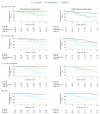Comparison of the Performance of 6 Prognostic Signatures for Estrogen Receptor-Positive Breast Cancer: A Secondary Analysis of a Randomized Clinical Trial
- PMID: 29450494
- PMCID: PMC5885222
- DOI: 10.1001/jamaoncol.2017.5524
Comparison of the Performance of 6 Prognostic Signatures for Estrogen Receptor-Positive Breast Cancer: A Secondary Analysis of a Randomized Clinical Trial
Abstract
Importance: Multiple molecular signatures are available for managing estrogen receptor (ER)-positive breast cancer but with little direct comparative information to guide the patient's choice.
Objective: To conduct a within-patient comparison of the prognostic value of 6 multigene signatures in women with early ER-positive breast cancer who received endocrine therapy for 5 years.
Design, setting, and participants: This retrospective biomarker analysis included 774 postmenopausal women with ER-positive ERBB2 (formerly HER2)-negative breast cancer. This analysis was performed as a preplanned secondary study of data from the Anastrozole or Tamoxifen Alone or Combined randomized clinical trial comparing 5-year treatment with anastrozole vs tamoxifen with 10-year follow-up data. The signatures included the Oncotype Dx recurrence score, PAM50-based Prosigna risk of recurrence (ROR), Breast Cancer Index (BCI), EndoPredict (EPclin), Clinical Treatment Score, and 4-marker immunohistochemical score. Data were collected from January 2009, through April 2015.
Main outcomes and measures: The primary objective was to compare the prognostic value of these signatures in addition to the Clinical Treatment Score (nodal status, tumor size, grade, age, and endocrine treatment) for distant recurrence for 0 to 10 years and 5 to 10 years after diagnosis. Likelihood ratio (LR) statistics were used with the χ2 test and C indexes to assess the prognostic value of each signature.
Results: In this study of 774 postmenopausal women with ER-positive, ERBB2-negative disease (mean [SD] age, 64.1 [8.1] years), 591 (mean [SD] age, 63.4 [7.9] years) had node-negative disease. The signatures providing the most prognostic information were the ROR (hazard ratio [HR], 2.56; 95% CI, 1.96-3.35), followed by the BCI (HR, 2.46; 95% CI, 1.88-3.23) and EPclin (HR, 2.14; 95% CI, 1.71-2.68). Each provided significantly more information than the Clinical Treatment Score (HR, 1.99; 95% CI, 1.58-2.50), the recurrence score (HR, 1.69; 95% CI, 1.40-2.03), and the 4-marker immunohistochemical score (HR, 1.95; 95% CI, 1.55-2.45). Substantially less information was provided by all 6 molecular tests for the 183 patients with 1 to 3 positive nodes, but the BCI (ΔLR χ2 = 9.2) and EPclin (ΔLR χ2 = 7.4) provided more additional prognostic information than the other signatures.
Conclusions and relevance: For women with node-negative disease, the ROR, BCI, and EPclin were significantly more prognostic for overall and late distant recurrence. For women with 1 to 3 positive nodes, limited independent information was available from any test. These data might help oncologists and patients to choose the most appropriate test when considering chemotherapy use and/or extended endocrine therapy.
Trial registration: isrctn.com Identifier: ISRCTN18233230.
Conflict of interest statement
Figures


References
-
- Massagué J. Sorting out breast-cancer gene signatures. N Engl J Med. 2007;356(3):294-297. - PubMed
-
- Harris LN, Ismaila N, McShane LM, et al. ; American Society of Clinical Oncology . Use of biomarkers to guide decisions on adjuvant systemic therapy for women with early-stage invasive breast cancer: American Society of Clinical Oncology Clinical Practice Guideline. J Clin Oncol. 2016;34(10):1134-1150. - PMC - PubMed
-
- Duffy MJ, Harbeck N, Nap M, et al. Clinical use of biomarkers in breast cancer: updated guidelines from the European Group on Tumor Markers (EGTM). Eur J Cancer. 2017;75:284-298. - PubMed
-
- Senkus E, Kyriakides S, Ohno S, et al. ; ESMO Guidelines Committee . Primary breast cancer: ESMO Clinical Practice Guidelines for diagnosis, treatment and follow-up. Ann Oncol. 2015;26(suppl 5):v8-v30. - PubMed
Publication types
MeSH terms
Substances
Grants and funding
LinkOut - more resources
Full Text Sources
Other Literature Sources
Medical
Research Materials
Miscellaneous

